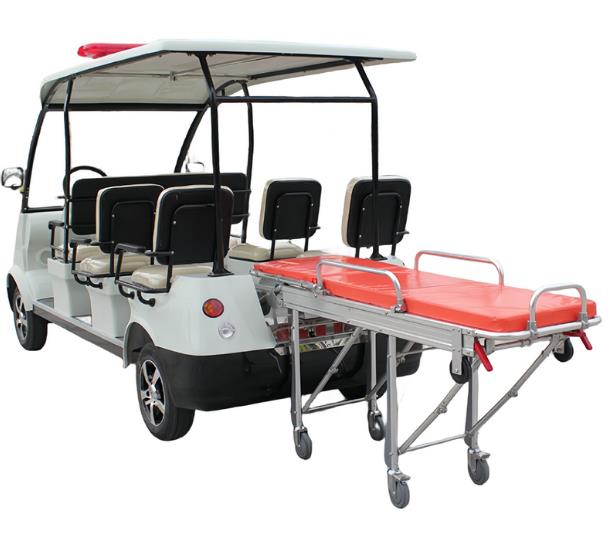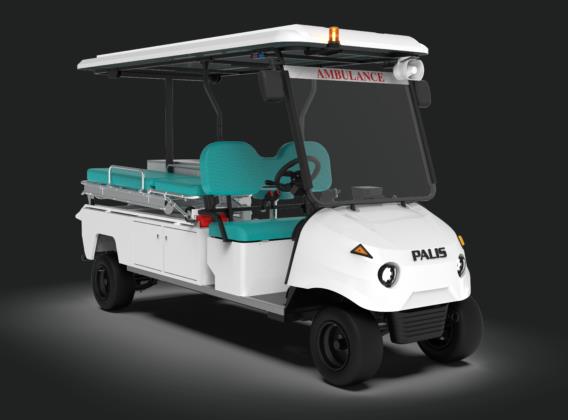Content Menu
● Environmental Benefits
● Cost-Effectiveness
● Improved Patient Comfort
● Technological Advancements
● Government Incentives and Public Perception
● Case Studies: Successful Implementations
● Future Developments and Challenges
● Expanding Applications
● Training and Education
● Conclusion
● FAQs
>> 1. What are the primary environmental benefits of electric ambulance carts?
>> 2. How do electric ambulance carts improve patient comfort?
>> 3. What technological advancements are available in electric ambulance carts?
>> 4. What financial incentives are available for hospitals adopting electric ambulance carts?
>> 5. How do electric ambulance carts contribute to cost savings for hospitals?
The integration of electric ambulance carts into hospital settings has become increasingly popular due to their numerous benefits. These vehicles not only contribute to environmental sustainability but also enhance patient care and operational efficiency. In this article, we will explore the top advantages of using electric ambulance carts in hospitals, including their environmental benefits, cost-effectiveness, improved patient comfort, and technological advancements.

Environmental Benefits
Electric ambulance carts are powered by electricity, which significantly reduces their carbon footprint compared to traditional fuel-powered vehicles. By minimizing emissions, these carts help combat air pollution and contribute to a healthier environment for both patients and staff. This aligns with global efforts to reduce greenhouse gas emissions and mitigate climate change.
- Zero Emissions: Electric carts produce no tailpipe emissions, reducing air pollution in urban areas where hospitals are often located. This is particularly important as air pollution is a major cause of respiratory and cardiovascular diseases, and hospitals play a crucial role in promoting public health.
Cost-Effectiveness
Despite higher initial costs, electric ambulance carts offer substantial long-term savings. The operational costs are lower due to reduced fuel consumption and maintenance needs. Electricity is generally cheaper than gasoline or diesel, allowing hospitals to allocate more resources to patient care and infrastructure development.
- Lower Maintenance Costs: Electric vehicles have fewer moving parts than traditional ambulances, resulting in fewer breakdowns and lower maintenance costs. This reduces the financial burden on healthcare facilities and ensures that resources are utilized more efficiently.
Improved Patient Comfort
Electric ambulance carts provide a quieter and smoother ride, which is crucial for patient comfort, especially during emergency situations. The reduced noise level minimizes stress and discomfort for patients, creating a more peaceful environment for both patients and medical staff.
- Quiet Operation: The silent operation of electric carts allows paramedics to communicate more effectively with patients and focus on providing quality care without distractions. This is particularly beneficial in sensitive environments such as hospitals or residential areas.

Technological Advancements
Electric ambulance carts often come equipped with advanced technology, including GPS tracking, real-time monitoring systems, and integration with medical devices. These features enhance the efficiency of emergency medical services and improve patient care by enabling real-time tracking and preparation for patient arrival.
- Advanced Medical Equipment: Some electric carts are designed with dedicated spaces for life support systems, diagnostic tools, and first-aid supplies. This ensures that medical personnel have access to necessary equipment during emergencies, improving response times and patient outcomes.
Government Incentives and Public Perception
Governments worldwide offer incentives such as tax credits and subsidies to encourage the adoption of electric vehicles. Hospitals that invest in electric ambulance carts can benefit from these incentives, reducing the upfront cost and enhancing their public image as environmentally responsible institutions.
- Improved Public Perception: By transitioning to electric vehicles, hospitals demonstrate their commitment to sustainability and public health, which can improve their reputation and community trust.
Case Studies: Successful Implementations
Several hospitals have successfully integrated electric ambulance carts into their operations. For example, in Kenya, a hospital used a golf cart-style electric mini ambulance to transport patients within the hospital premises. This innovation reduced manual handling by nurses, improved patient comfort, and contributed to environmental sustainability.
- Operational Efficiency: The use of electric carts in hospitals also enhances operational efficiency by allowing for quicker and more efficient patient transport. This is particularly beneficial in large hospital complexes where distances between departments can be significant.
Future Developments and Challenges
As technology advances, electric ambulance carts are expected to become more prevalent. However, challenges such as charging infrastructure and battery durability need to be addressed to ensure widespread adoption. Innovations like fast charging and battery swapping can help mitigate these challenges.
- Solar-Powered Options: Some electric carts are being developed with solar power capabilities, further reducing their environmental impact by relying on renewable energy sources. This could be particularly beneficial in areas with abundant sunlight, providing a sustainable solution for charging.
Expanding Applications
Beyond traditional hospital settings, electric ambulance carts can be used in various scenarios such as outdoor events, remote areas, or disaster response situations. Their versatility and environmental benefits make them an attractive option for emergency services looking to modernize their fleets.
- Community Outreach: Electric carts can also be used for community outreach programs, providing medical services in rural or underserved areas where traditional ambulances may face challenges. This expands healthcare access and promotes community health initiatives.
Training and Education
The successful integration of electric ambulance carts requires proper training for medical staff. This includes understanding the operational capabilities of the carts, how to handle them safely, and how to utilize their advanced features effectively.
- Workshop Programs: Hospitals can organize workshops and training sessions to educate staff about the benefits and operational procedures of electric carts. This ensures a smooth transition and maximizes the potential of these vehicles in enhancing patient care.
Conclusion
Electric ambulance carts offer a range of benefits for hospitals, from environmental sustainability and cost savings to improved patient comfort and technological advancements. As the healthcare sector continues to evolve, the adoption of electric vehicles will play a crucial role in modernizing emergency medical services while contributing to a healthier environment.

FAQs
1. What are the primary environmental benefits of electric ambulance carts?
Electric ambulance carts reduce air pollution by producing zero tailpipe emissions, contributing to cleaner air and a healthier environment for both patients and staff.
2. How do electric ambulance carts improve patient comfort?
Electric carts provide a quieter and smoother ride, minimizing stress and discomfort for patients during transport. This is particularly beneficial for critical or sensitive patients.
3. What technological advancements are available in electric ambulance carts?
These carts often feature GPS tracking, real-time monitoring systems, and integration with advanced medical devices, enhancing the efficiency and quality of emergency medical services.
4. What financial incentives are available for hospitals adopting electric ambulance carts?
Governments offer incentives such as tax credits and subsidies to encourage the transition to electric vehicles, reducing the upfront cost for hospitals.
5. How do electric ambulance carts contribute to cost savings for hospitals?
Electric carts have lower operational costs due to reduced fuel consumption and maintenance needs. This allows hospitals to allocate more resources to patient care and infrastructure development.










































